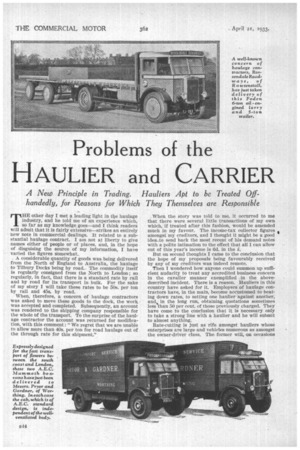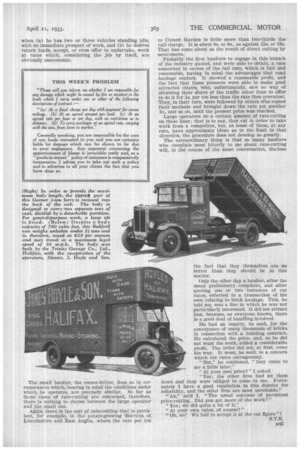Problems of the
Page 58

Page 59

If you've noticed an error in this article please click here to report it so we can fix it.
HAULIER and CARRIER THE other day I met a leading light in the haulage induStry, and he told me of an experience which, so far as my knowledge goes—and I think readers will admit that it is fairly extensive—strikes an entirely new note in commercial dealings. It related to a substantial haulage contract. I am not at liberty to give names either of people or of places, and, in the hope of disguising the source of my information, I have varied the figures somewhat.
-A considerable quantity of goods was. being delivered from the North of England to Australia, the haulage to Tilbury Docks being by road. The commodity itself is regularly consigned from the North to London ; so regularly, in fact, that there is a standard rate by rail and by road for its transport in bulk. For the sake of my story I will take these rates to be 50s. per ton by rail and 45s. by road.
When, therefore, a concern of haulage contractors was asked to move these goods to the dock, the work was accepted and completed. Subsequently, an account was rendered to the shipping company responsible for the whole Of the transport. To the surprise of the haulage contractor the account was returned for modification, with this comment : "We regret that we are unable to allow more than 40s. per ton for road haulage out of the through rate for this shipment." When the story was told to me, it occurred to me that there were several little transactions of my own which, if treated after this fashion, would be amended much in my favour. The income-tax collector figures amongst my creditors, and I thought it might be a good idea to send back the most recent of his demand notes with a polite intimation to the effect that all I can allow out of this year's income is 6d. in the £.
But on second thoughts I came to the conclusion that the hope of my proposals being favourably received by any of my creditors was indeed remote. Then I wondered how anyone could summon up sufficient audacity to treat any accredited business concern in the cavalier manner exemplified in the abovedescribed incident. There is a reason. Hauliers in this country have asked for it. Employers of haulage contractors have, in the main, become accustomed to beating down rates, to setting one haulier against another, and,, in the long run, obtaining quotations sometimes less than 50 per cent. of those previously charged. They have come to the conclusion that it is necessary only to take a strong line with a haulier and he will submit to almost anything.
Rate-cutting is just as rife amongst hauliers whose enterprises are large and vehicles numerous as amongst the owner-driver class. The former will, -on occasions when (a) he has two or three vehicles standing idle, with no immediate prospect of work, and (b) he desires return loads, accept, or even offer to undertake, work at rates which, considering the job by itself, are obviously uneconomic.
(Right) In order to provide the maximum body length, the tipping gear of this Garner 2-ton lorry is recessed into the back of the cab. The body is designed to carry two separate tons of coal, divided by a detachable partition. For general-purpose work, a loose tilt is fitted. (Below) Despite a body capacity of 760 cubic feet, this Bedford van weighs unladen under 2} tons and is, therefore, taxed at £28 per annum and may travel at a maximum legal speed of 30 m.p.h. The body was built by the Trinity Garage Co., Ltd., Halifax, with the co-operation of the operators, Messrs. 1. Hoyle and Son.
The small haulier, the owner-driver, does so in circumstances which/ bearing in mind the conditions Under which he operates, are precisely similar. So .far as those cases of rate-cutting are concerned, therefore, there is nothing to choose between the large, operator and the. small one.
Again, there is the sort of rate-cutting that is prevalent, forexaMple,in the Potate-growing lliStricts of Lincolnshire and East A.nglia, where the rate per ton to Covent Garden is little more than two-thirds the rail charge. It is about 8s. or 9s., as against 12s. or 13s. That has come about as the result of direct cutting by newcomers.
Probably the first hauliers to engage in this branch of the industry quoted, and were able to obtain, a rate somewhat in excess of the rail rate, which is fair and reasonable, having in mind the advantages that road haulage confers. It showed a reasonable profit, and the fact that these pioneers were able to make good attracted others, who, unfortunately, saw no way of obtaining their share of the traffic other than to offer to do it for is. per ton less than the rate then prevalent. They, in their turn, were followed by others who copied their methods and brought down the rate yet another is., and so on, until the present price was reached.
Large operators do a certain amount of rate-cutting on these lines; that is to say, .they cut in order to take • work from a competitor, but, as some of them, at any rate, have approximate ideas as to the limit in that direction, the procedure does not develop so greatly.
The extraordinary thing is that so many hauliers who complain most bitterly to me about rate-cutting will, in the course of the same conversation, disclose the fact that they themselves are no better than they should be in this matter.
Only the other day a haulier, after the usual preliminary complaint, and after quoting one or two instances of cut rates, referred to a transaction of his own relating to brick haulage. This, he told me, was a line in which he was not particularly interested. It did not attract him, because, as everyone knows, there is a good deal of handling involved.
He had an inquiry, he said, for the conveyance of many thousands of bricks in connection with a building contract. Be calculated the price, and, as he did not want the work, added a considerable profit. The order did not, at first, come his way. It went, he said to a concern which cut rates outrageously.
"But,". he continued, 'they came to me a little later."
"At your own price?" I asked.. "Yes; the other firm had let them down and they were obliged to come to me. Fortunately I have a good reputation in this district for reliability, and the other firm are most unreliable." " Ah," said 1. "The• usual outcome of persistent price-cutting. Did you get. more of the work?"
" Yes ; we did quite a lot of it."
"At your own rates, of• course?"
" Oh, no! We had to accept it at the cut figure "! S.T.R. s45




























































































